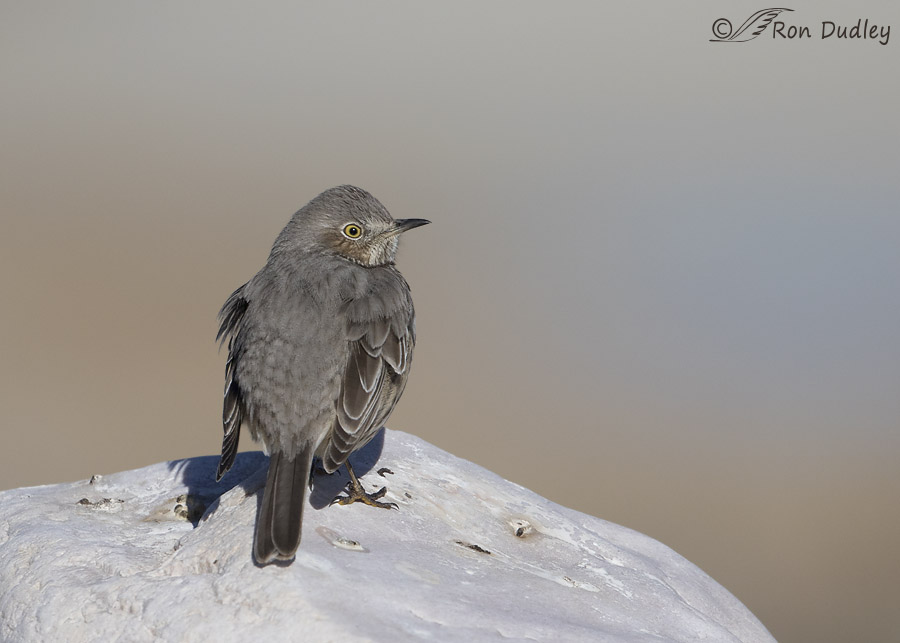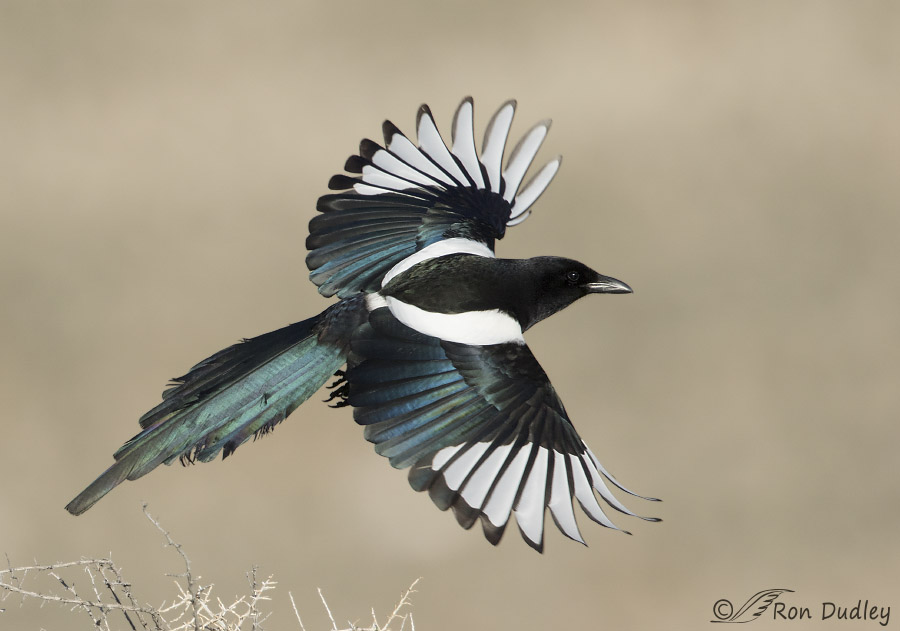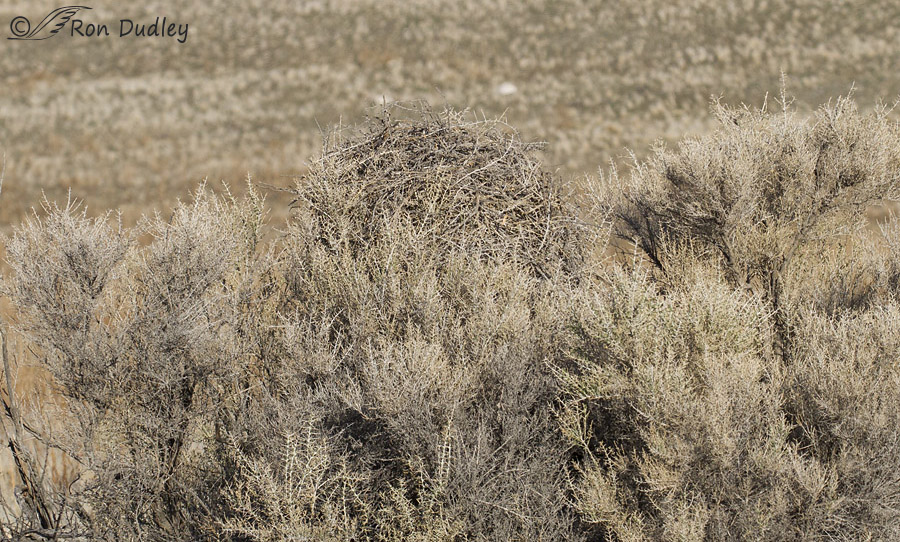Before we get to the main event of this post I must report that a pleasant surprise awaited me on Antelope Island yesterday morning.
Some will recall that my impatience over the return of Sage Thrashers to northern Utah was the subject of yesterday’s post. Normally I don’t see them until early April but I’d been missing them on the island lately so I posted some thrasher images out of fondness and anticipation, fully expecting another several weeks to pass before I encountered one.

1/5000, f/6.3, ISO 500, Canon 7D Mark II, Canon EF500mm f/4L IS II USM +1.4 tc, not baited, set up or called in
So what a joy (and coincidence) it was to find this Sage Thrasher and several others flitting around the Tintic Quartzite boulders on the north end of the island! I don’t recall ever seeing them this early so I suspect that the timing of their migration has been influenced by our unusually warm winter and early spring. I just looked back through my files and the earliest I’ve photographed the species in this area has been April 10 (though I’d seen a few birds slightly earlier).

1/2500, f/6.3, ISO 500, Canon 7D Mark II, Canon EF500mm f/4L IS II USM +1.4 tc, not baited, set up or called in
But one of my favorite images from yesterday morning was this Black-billed Magpie taking off from its nest bush. I like the good look at the topside of the bird and of course the iridescence. This bird and its mate were busy hauling twigs and mud to their nest so their bills were often plastered with mud but this time the magpie had “cleaned up” for its portrait, though there wasn’t much it could do about that somewhat ratty tail.
 This is one of the nests I’ve been photographing for several years now. Magpie nests tend to be large, domed structures made of sticks and twigs with an internal mud bowl with a grass lining, though there’s great variation among nests which suggests that cultural traditions influence nest-building. It’s even thought that magpies may imprint on their natal nests and later construct similar ones.
This is one of the nests I’ve been photographing for several years now. Magpie nests tend to be large, domed structures made of sticks and twigs with an internal mud bowl with a grass lining, though there’s great variation among nests which suggests that cultural traditions influence nest-building. It’s even thought that magpies may imprint on their natal nests and later construct similar ones.
As always I take great care to avoid disturbing birds anywhere near their nests. These magpies are acclimated to human presence on the island but even so I don’t ever approach the nest and I watch their behavior for any signs of disturbance. I always shoot from inside my pickup and from the road. Shooting at an effective focal length of 1120mm (500mm lens x 1.4 teleconverter x 1.6 crop factor of my camera) allows me to get fairly close optically rather than physically and you don’t have to get very close for flight shots anyway. In fact there are times when these birds almost crawl under my pickup in their quest for nesting material.
I’m fully aware that some folks don’t much appreciate magpies but over the years they’ve become one of my favorite subjects.
Ron


I have never seen a nest in shrubbery like this-how tall are they? usually see nests in trees that are one or two stories high.i found this fascinating.
Wonderful shots, great to have the Thrashers back, and how wonderful to have access to the Magpie ‘ s nest!
Charlotte
That Sage Thrasher looks really spunky. It made me smile. You can post as many of those as you want, for me, because I can always afford to find a smile. Magpies, especially when you can catch the iridescence, definitely make good photographic subjects. Too bad about the ratty tail, but it is otherwise a great shot.
Great shots as usual Ron. I especially love the Magpie iridescent and am starting to look for it…thanks for the lessons you give…Jer
I hope our magpies never see photos of yours – they would get teeny, weeny inferiority complexes. Or perhaps they would just talk about ‘all bling, and no substance’.
Love yours (and ours) and am very, very pleased that the Sage Thrasher responded to your plea.
Wow! Two beauties to start the day– the sassy little, bright-eyed Thrasher…all fluffed up with attitude, and the elegant, iridescent beauty of the Magpie, which, thanks to you, has become one of my favorite birds…one I’m always excited to see. I particularly love the graceful curve of the right wing primaries. I also wondered about coyotes plundering the nest and am relieved to learn they probably can’t… (I have never seen one of your blogs without learning something new and interesting)
“I have never seen one of your blogs without learning something new and interesting”
Thank you, Patty. That means a lot.
IOVE THOSE MAGGIES!!
I have to tell you that I actually held an injured pheasant a few years ago. He had an injured wing and the dog brought him up to the
house. (it was -19) Anyway, I held him inside my coat for an hour or so and talked to him. Then we took him down where we knew lived
and we turned him loose. We have seen him off and on since. I always watch for him.
Last fall my son found an injured bald eagle. He called a lady from Cody who helps injured birds. She went up to Fromberg and got the him
and took him home for healing. She said he will heal up and then be released back at Fromberg. My son is the line superintendent for
Beartooth REA at Red Lodge so occasionally they find injured birds and he calls the lady from Cody to help them.
Have a gret day!
Neat stories, Claudia. These days birds need all the help they can get.
Thanks for including the photo and info on the magpies’ nest—I’ve seen these gorgeous ( if occasionally abrasive ) birds all my life, and never was aware of the impressive nest !
“occasionally abrasive”
Yep, they can be that, Kris. I once had a magpie nest in a tree in my yard and their noisy early (very early) morning antics weren’t always welcome. But overall I wish the nest was still there. I used to love watching them torment the neighbor’s cats.
I’d love to see that nest over the years. Has it grown or does it maintain the same size? I wonder if some springs Mrs. Magpie says, “We have GOT to redo the south side. I’m so tired of that sagebrush wallpaper.”
😀
Arwen, they “refurbish” the nest every year, adding twigs and redoing the internal mud bowl. The nest gets larger but so does the bush so it’s hard to hell how much bigger it gets.
It was special birding news here in Pensacola when a Sage Thrasher was spotted at Ft. Pickens in Jan. 2011. I got a decent photo but it would take a Photoshop geek to give it a background like the images you and Mia posted today. Great Magpie shot.
I thought you WERE a Photoshop geek, Dave! Just kidding… I’ll bet you were as excited about your thrasher as I was about mine.
Beautiful shots, Ron. I’ve never seen a magpie, (we don’t have them in Tulsa, OK) but I tend to love the corvids the most. I must ask you, Ron; do their nest fall prey to coyotes often? I’m shocked that they build on the ground!
Leslie, they don’t build on the ground. This is a relatively large bush and the nest is probably about 6′ off the ground. The nest is on the middle-top of the bush and all those prickly branches and twigs give it good protection. I’ve never seen coyotes attempt to bother a magpie nest and believe they would have a difficult time doing so. All that said, in areas where there are higher trees (there aren’t any nearby) magpies often build their nests higher up.
In addition, whenever there are coyotes nearby flocks of magpies often harass them mercifully. The coyotes can only take it for so long and then they usually vamoose.
I am here to sing my praise of magpies. Your photos are, as usual, very well done. I’ve been learning so much about birds. Many thanks.
I agree, Bill – magpies are certainly deserving of praise for a variety of reasons. Thank you.
Thanks again, Ron for your beautiful captures. I’m originally from Michigan & have lived in Florida for almost 30 years. I’ve never seen either of these birds before. I’m so blown away by the beauty of the Magpie & the sweetness of the Sage Thrasher & you make it possible for me to “see” them. I also loved seeing the magpie’s nest. I’ve seen photos of Bald Eagles nests & the SW FL eagle nest live & their construction just amazes me. I keep falling in love with our bird population & so admire their work ethics.
Jo Ann, I just learned something. I thought (assumed) that magpie range included much of the Great Lakes region but your comment about Michigan sent me to my field guide and I see that it does not. I’m delighted that you appreciate my images of birds that you normally don’t see. Thank you.